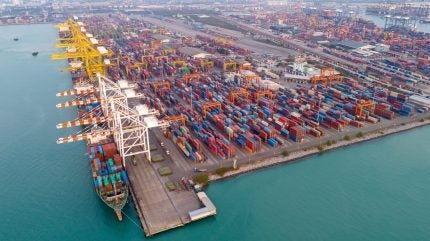
The congestion seen at some of the world’s major ports beginning with the crisis in the Red Sea appeared to be past its peak, but the shipping industry could be hit by looming strikes, according to a leading shipping analyst.
Freightos found that while congestion was still affecting global shipping routes, the worst of the problem appeared to be behind the industry, with traffic at the Port of Singapore below May and June levels, although some vessels are still waiting up to three days to dock.
The port had been one of the worst hit by increased traffic in South Asia as ships made early stops before taking the long trip to Europe around the Cape of Good Hope, as a diversion around the conflict-struck Red Sea and Suez Canal.
Judah Levine, Freightos’ head of research, said congestion was being alleviated by a natural easing in freight volumes as the industry reached an early end to its peak season, brought on by an early beginning to the season as shippers moved goods early to compensate for longer transits.
Levine said: “On the demand side, the levelling off or decreasing of rates, and reports of more allocations being honoured, meaning shippers are having an easier time securing spot shipments, may show that the early start to peak season is about to lead to an earlier start to easing demand.”
This, combined with direct measures like the omission of stops at some Asian and North European ports by operators such as the 2M Alliance to avoid traffic, appeared to be helping keep delays down despite the Red Sea crisis remaining unlikely to end soon.
Speaking during a webinar on the future of the industry, Levine also highlighted the strength of the market despite the issues seen in 2024, with global container volumes predicted to have peaked at around 2.3 million TEUs in July and August, only slightly below the record 2.4 million TEU peak seen in mid-2022.
Shipping operators may still be concerned about the near future for the industry, as Northern European hubs showed early signs of congestion, and a range of incoming factors meaning there is no clear forecast for the second half of 2024 and early 2025.
In particular, Levine highlighted the threat of strike action at ports across the world, with dockworkers at India’s 12 largest ports already voting to strike on 28 August and rail workers close to strike action in Canada.
Fears of dramatic strike action are heightened in the US as the deadline looms for an agreement on a new contract for the International Longshoremen’s Association (ILA), whose workers have committed to strike at dozens of ports along the East Coast and Gulf of Mexico.
ILA President Harold Daggett said the association would “stand strong to win a new contract” that “adequately compensates” its members by 1 October, but warned: “there will be no extensions offered to the US Maritime Alliance so their time is running out.”
Strikes in the US could cause months of backlogs in the region, similar to the issues seen in Canada after 13 days of strike action by port workers in the province of British Columbia in 2023.



